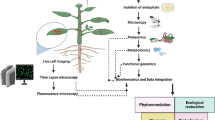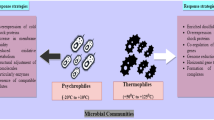Abstract
Genetic selection can be a powerful tool to increase beneficial traits in biological control agents. In this study the heat and desiccation tolerance of the entomopathogenic nematode Heterorhabditis bacteriophora Poinar (Rhabditidomorpha: Strongyloidea) were significantly increased by cross breeding tolerant parental strains and successive genetic selection. These strains originated from a prior screening among 60 strains for increased stress tolerance. During genetic selection, the selection pressure was constantly increased and only the most tolerant 10% of the nematode populations were propagated for further selection steps. Assessment of tolerance and selection for both traits was performed with and without prior adaptation to the stress conditions. Eleven selection steps were performed to increase heat tolerance. A final overall increase in mean heat tolerance of 5.5°C was achieved when nematodes had been adapted to heat stress. For non-adapted tolerance an increase of 3.0°C from 40.1°C to 43.1°C was recorded. For comparison, a commercial strain had a mean tolerated temperature after adaptation of 38.2°C and of 36.5°C without adaptation. For assessment of the desiccation tolerance the mean tolerated water activity (aw-value) of a population was measured. Cross-breeding most tolerant strains reduced the aw-value from 0.67 to 0.65 after adaptation and from 0.9 to 0.7 without prior adaptation. The following six selection steps could not increase the tolerance whether nematodes had been adapted to stress or not. In comparison, the commercial strain tolerated a mean aw-value of 0.985 after adaptation and 0.951 without adaptation. Further investigation will have to assess trait stability and possible trade-off effects. This study is a first important step on the road towards domestication of the entomopathogenic nematode H. bacteriophora.





Similar content being viewed by others
References
Dix I (1994) Use of second generation Heterorhabditis females for genetic crosses. In: Burnell AM, Ehlers R-U, Masson JP (eds) Genetics of entomopathogenic nematode-bacterium complexes. COST 812-Biotechnology, EUR 15681 EN. European Commission, Directorate General XII, Luxembourg, pp 190–193
Ehlers R-U, Oestergaard J, Hollmer S, Wingen M, Strauch O (2005) Genetic selection for heat tolerance and low temperature activity of the entomopathogenic nematode-bacterium complex Heterorhabditis bacteriophora—Photorhabdus luminescens. BioControl 50:699–716
Ehlers R-U (2001) Mass production of entomopathogenic nematodes for plant protection. Appl Microbiol Biotechnol 56:623–633
Gaugler R (1986) Feasibility of genetically improving steinernematid and heterorhabditid nematodes. In: Samson RA, Vlak JM, Peters D (eds): Fundamental and applied aspects of invertebrate pathology. Proceedings of the Fourth International Colloquium of Invertebrate Pathology, Veldhoven, 18–22 August, The Netherlands, pp 300–303
Gaugler R, Campbell JF, McGuire T (1989) Selection for host-finding in Steinernema feltiae. J Nematol 54:363–372
Glazer I, Gaugler R, Segal D (1991) Genetics of the entomopathogenic nematode Heterorhabditis bacteriophora (strain HP88): the diversity of beneficial traits. J Nematol 23:324–333
Grewal PS (2000) Anhydrobiotic potential and long-term storage of entomopathogenic nematodes (Rhabditida: Steinernematidae). Int J Parasitol 30:995–1000
Grewal PS (2002) Formulation and application. In: Gaugler R (ed): Entomopathogenic nematology. CABI International, Wallingford, UK, pp 265–287
Grewal PS, Wang X, Taylor RAJ (2002) Dauer juvenile longevity and stress tolerance in natural populations of entomopathogenic nematodes: is there a relationship? Int J Parasitol 32:717–725
Hartl DL, Clark AG (1989) Principles of population genetics. 2nd edn. Sinauer Association, Sunderland, Massachusetts
Hominick MW (2002) Biogeography. In: Gaugler R (ed): Entomopathogenic nematology. CABI International, Wallingford, UK, pp 115–143
Iraki N, Salah N, Sansour N, Segal D, Glazer I, Johnigk SA, Hussein M, Ehlers R-U (2000) Isolation and characterization of two entomopathogenic nematode strains, Heterorhabditis indica (Nematoda, Rhabditia), from the West Bank, Palestinian Territories. J Appl Entomol 124 375–380
Johnigk SA, Hollmer S, Strauch O, Wyss U, Ehlers R-U (2002) Heritability of the liquid culture mass production potential of the entomopathogenic nematode Heterorhabditis bacteriophora Biocontrol Sci Technol 12:267–276
Johnigk SA, Ehlers R-U (1999) Juvenile development and life cycle of Heterorhabditis bacteriophora and H. indica (Nematoda: Heterorhabditidae). Nematology:251–260
Łączyński A, De Moor A, Dierickx W, Moens M, Darius P, Sonck B, Ramon H (2006) The effect of hydraulic agitation on the viability of the nematode Heterorhabditis bacteriophora. Crop Protec 25:1135–1141
Lunau S, Stoessel S, Schmidt Peisker AJ, Ehlers R-U (1993) Establishment of monoxenic inocula for scaling up in vitro cultures of the entomopathogenic nematodes Steinernema spp. and Heterorhabditis spp. Nematologica 9:385–399
Mukuka J, Strauch O, Waeyenberge L, Ehlers R-U (2010a) Heat tolerance variations among different strains of the entomopathogenic nematode Heterorhabditis spp. BioControl. doi:10.1007/s10526-009-9255-4
Mukuka J, Strauch L, Ehlers R-U (2010b) Variability in desiccation tolerance among different strains of the entomopathogenic nematode Heterorhabditis spp. Nematology. doi:10.1163/138855409X12607871174454
Popiel I, Holtemann KD, Glazer I, Womersley C (1988) Commercial storage and shipment of entomogenous nematodes. Int Patent No WO88/01134
Shapiro DI, Glazer I, Segal D (1997) Genetic improvement of heat tolerance in Heterorhabditis bacteriophora through hybridisation. Biol Control 8:153–159
Somasekhar N, Grewal PS, Klein MG (2002) Genetic variability in stress tolerance and fitness among natural populations of Steinernema carpocapsae. Biol Control 23:303–310
Somvanshi VS, Koltai H, Glazer I (2008) Expression of different desiccation-tolerance related genes in various species of entomopathogenic nematodes. Mol Biochem Parasitol 158:65–71
Strauch O, Stoessel S, Ehlers R-U (1994) Culture conditions define automictic or amphimictic reproduction in entomopathogenic rhabditid nematodes of the genus Heterorhabditis. Fundam Appl Nematol 17:575–582
Strauch O, Niemann I, Neumann A, Schmidt AJ, Peters A, Ehlers R-U (2000) Storage and formulation of the entomopathogenic nematodes Heterorhabditis indica and H. bacteriophora. BioControl 45:483–500
Strauch O, Oestergaard J, Hollmer S, Ehlers R-U (2004) Genetic improvement of the desiccation tolerance of the entomopathogenic nematode Heterorhabditis bacteriophora through selective breeding. Biol Control 31:218–226
Acknowledgments
The scholarship to the first author by the DAAD (Deutscher Akademischer Austauschdienst, http://www.daad.de) is highly appreciated.
Author information
Authors and Affiliations
Corresponding author
Additional information
Handling editor: Eric Wajnberg.
Rights and permissions
About this article
Cite this article
Mukuka, J., Strauch, O., Hoppe, C. et al. Improvement of heat and desiccation tolerance in Heterorhabditis bacteriophora through cross-breeding of tolerant strains and successive genetic selection. BioControl 55, 511–521 (2010). https://doi.org/10.1007/s10526-010-9271-4
Received:
Accepted:
Published:
Issue Date:
DOI: https://doi.org/10.1007/s10526-010-9271-4




